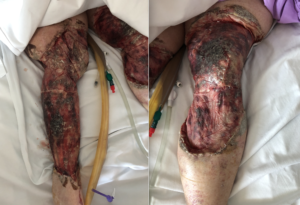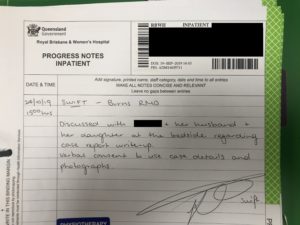Case Study
Abstract
A 71-year-old female was transferred to a tertiary trauma centre in Brisbane 5 days post crush injury to bilateral lower limbs after being rolled over by a four-wheel drive. She had extensive circumferential degloving with heavy contamination and fascial defects, and a breach in the right knee joint capsule with exposed joint prosthesis.
The wound underwent extensive debridement and washout day 1 post injury. KCI V.A.C.TM dressings were applied individually to both lower limbs on continuous low pressure suction, with Acticoat FlexTM (a silver impregnated dressing) to exposed fat, black foam, and hydrocolloid dressings to the periwound skin. Repeat debridement and dressing changes occurred every three days. After the third debridement, V.A.C. VerafloTMTherapy with Normal Saline instillation was applied with a 15 minute dwell time, followed by 3.5hrs of continuous negative pressure at 125 mmHg.
At 3 weeks post injury, tissue coverage of the joint capsule defect was achieved with a pedicled medial gastrocnemius flap, and then BTMTM (Biodegradable Temporising Matrix) was applied to the wound bed as a dermal matrix. The V.A.C. dressings were removed on the ward at one month post injury and then managed with simple wound dressings every three days. The patient is planned for delamination of BTMTM and a split thickness skin graft for full skin coverage in two weeks, and is expected to regain full function after intensive rehabilitation.
Introduction
Negative pressure wound therapy (NPWT) is well established in literature and clinical practise for the management of acute and chronic wounds. Subatmospheric pressure over a wound bed accelerates healing by creating a favourable warm and moist environment, promoting perfusion, and reducing local factors that impede healing such as oedema, excessive exudate, local infection and poor wound edge apposition.1 This leads to simpler and less frequent dressing changes, faster time to definitive wound closure, and reduced complexity of reconstructive surgery. There is also evidence to suggest that NWPT may be more cost effective than standard care.2
The authors present a case of a complex crush injury which was successfully managed using NWPT in the acute phase. The V.A.C. VerafloTM system discussed in this case report is a vacuum-assisted closure device with automated controlled delivery of topical treatment solutions. This theoretically assists with wound cleansing by loosening and removing soluble contaminants in the wound bed between dressing changes.
Method and Results
A 71-year-old female presented to a tertiary hospital via fixed wing aircraft with bilateral circumferential lower limb degloving injury day 5 post vehicle roll over by a four-wheel drive. She had extensive soft tissue loss on bilateral lower limbs, a comminuted open right fibula head fracture, complete attritional rupture of her MCL and a breach in her right knee joint capsule with a scuffed metal prosthesis at the medial right knee (shown in Figure 1). Her past medical history was significant for previous splenic infarct for which she is warfarinised, bronchiectasis, mitral valve disease, hypertension and obesity (BMI 38). Her past surgical history of note is a right total knee replacement 11 years ago via a medial parapatellar approach for osteoarthritis. She is a lifelong non-smoker and previously independent of all activities of daily living.
On arrival to hospital, she received 2g IV ceftriaxone and an ADT booster. A tertiary survey was negative for other injuries, and a CT angiography in combination with clinical exam revealed no neurovascular injury.
Figure 1: Clinical photos taken day 1 post injury, showing lower limb wounds prior to debridement and transfer

On day 1 post injury she underwent initial washout and extensive debridement under general anaesthetic, and a KCI V.A.C. was applied individually to each leg on continuous low pressure suction. The right lower limb had circumferential massive degloving, with lacerations and skin flaps spanning the entire length of the leg and associated fascial defects and muscle tears. There was a 2cm breach in the joint capsule medially with tibial prosthetic component and poly on view. The left lower limb was less severe, with a 30cm oblique laceration spanning the anterolateral aspect of the left knee, extending into the popliteal region and lower third of the leg. Both wounds were heavily contaminated with gravel/dirt/mud and necrotic tissue. She underwent repeat washout on day 4 post injury and V.A.C. dressings were reapplied, with Acticoat FlexTM over exposed fat, black foam dressing and hydrocolloid dressing borders.
The patient was managed in the intensive care unit for critical anaemia (Hb 53) requiring 6 units of packed red blood cells. Consequently, she suffered a watershed stroke with prolonged altered level of consciousness, right hemiplegia and right-sided neglect, and an acute kidney injury requiring a short period of haemodialysis. On the background of her cardiac history and a critically low albumin, she also became clinically overloaded with acute pulmonary oedema requiring BiPAP. Given the complexity of her injuries, on day five she was transferred to a major trauma centre in Brisbane for coordinated multidisciplinary care between the burns, plastic surgery and orthopaedic teams.
At the time of her next wound debridement and dressing change on day 7 post injury, she was changed to a negative pressure dressing with instillation therapy. A V.A.C. VerafloTM was applied to each lower limb separately overlying black foam, with hydrocolloid dressings to the peri-wound skin. This was set to 150mL for 3 minutes every 3.5 hours at 100mmHg of negative pressure. She then required dressing changes every three days. Her wounds following debridement to healthy tissue can be seen in Figure 2, and when covered with a V.A.C. VerafloTM dressing in Figure 3.
Figure 2: Clinical photos taken day 14 post injury, showing the extent of debridement surgical debridement to healthy tissue

Figure 3: Clinical photos taken day 14 post injury after re-application of V.A.C. VerafloTM for negative pressure wound therapy with instillation

Deep operative specimens from her early wound debridements grew candida albicans, and based on sensitivities she was commenced on IV fluconazole to mitigate the risk of prosthetic joint infection. At day 18 post injury, she underwent a combined case with orthopaedics and plastic surgery for a final joint washout and replacement of the poly liner in her prosthetic knee joint, MCL repair, and a medial gastrocnemius flap to cover the capsular defect.
Finally, at day 21 post injury, BTMTM (biodegradable temporising matrix) was applied to healthy wounds, secured with staples and dressed with ActicoatTM, black foam and V.A.C. dressing on continuous 125mmHg negative pressure. BTMTM is a synthetic polyurethane foam matrix employed as a dermal replacement strategy, as shown in Figure 4. Her gastrocnemius flap was inset and alive, adherent to surrounding tissue, and adequately covering the previously exposed metalwear. Her V.A.C. dressings were removed on the ward one month post injury, after a total of 30 days of negative pressure therapy.
Figure 4: Clinical photos taken day 30 post injury, with no further surgical debridement planned and BTMTM in situ

Her BTMTM remains in situ, with simple ActicoatTM dressings changed every three days, and will be delaminated after fully integrating with new vascularised tissue to allow for split thickness skin grafting. She will require intensive rehabilitation with physiotherapy given her prolonged period of immobility and deconditioning, however is expected to regain function of both lower limbs and return to her previously independent state. She will require long-term fungal suppression therapy with fluconazole whilst awaiting a two-stage revision of her right total knee replacement.
Discussion
This patient represents a complex case in every stage of management, with both life-threatening traumatic injuries and extensive tissue loss, complex medical comorbidities and complications of resuscitation. Without early aggressive debridement and optimal wound management, her injuries could easily have progressed to amputation or death.
Whilst it is difficult to quantify the economic value of negative pressure wound therapy in this patient, it can be extrapolated that her optimum wound management prevented a longer hospital stay and the alternative course of treatment, which was amputation over limb salvage. Negative pressure wound therapy provided interim coverage between each surgical debridement, reduced the need for dressing changes and manipulation on the ward, and facilitated reduction of oedema in the setting of immobility and hypoalbuminemia.
There is a paucity of evidence to support negative pressure wound therapy over standard wound management, due to heterogenous data and significant bias.3 However, in animal models NWPT has been shown to create a favourable wound environment and therefore to accelerate healing and facilitate early wound closure.4 With regards to NPWT with instillation (NPWTi), a review in 2015 showed that NPWTi provided better overall clinical outcomes in combination with standard cares, and recommended its use in patients with multiple comorbidities, severe traumatic wounds, or wounds complicated by biofilm or invasive infection.5 A comparative study of NPWTi versus NPWT in 2016 then suggested decreased hospital length of stay and accelerated wound healing in the NPWTi group.6 Further research is required for good quality evidence that can guide clinical practise.
Conclusion
The authors present a case of massive lower limb degloving injury with exposed prosthetic joint in an elderly comorbid patient. This was successfully managed with irrigating negative pressure wound therapy using a V.A.C. VerafloTM dressing and serial surgical debridements, followed by application of BTMTM to establish a healthy granulating base. The judicious use of V. A. C. VerafloTM allowed for management of soluble contaminants, coverage of the joint, healthy granulation tissue and ultimately salvage of both legs.
Ethics Statement:
This case study is unpublished and has not been submitted elsewhere. Informed consent was obtained from the patient and her family, including for the use of photographs, and this has been documented in her hospital record. All information has been de-identified to maintain patient confidentiality.

Declarations of Interest:
This manuscript has been submitted to the V.A.C. VERAFLO Therapy (Acelity)TM case study competition for an educational grant, hosted by Wounds International and KCI. The authors declare no other conflicts of interest.
References
- Venturi ML, Attinger CE, Mesbahi AN, Hess CL, Graw KS. Mechanisms and clinical applications of the vacuum-assisted closure (VAC) Device: a review. Am J Clin Dermatol. 2005;6(3):185.
- Webster J, Liu Z, Norman G, Dumville JC, Chiverton L, Scuffham P, Stankiewicz M, Chaboyer WP. Negative pressure wound therapy for surgical wounds healing by primary closure (Review). Cochrane Database of Systematic Reviews. 2019, Issue 3. Art. No.: CD009261. DOI: 10.1002/14651858.CD009261.pub4.
- Peinemann F, Labeit A. Negative pressure wound therapy: A systematic review of randomised controlled trials from 2000 to 2017. J Evid Based Med. 2019;12(2):125-132.
- Morykwas MJ, Argenta LC, Shelton-Brown EI, McGuirt W. Vacuum-assisted closure: a new method for wound control and treatment: animal studies and basic foundation. Ann Plast Surg. 1997;38(6):553.
- Kim PJ, Attinger CE, Crist BD, Gabriel A, Galiano RD, Gupta S, Lantis Ii JC, Lavery L, Lipsky BA, Teot L. Negative pressure wound therapy with instillation: review of evidence and recommendations. Wounds. 2015;27(12):S2-S19.
- Omar M, Gathen M, Liodakis E, Suero EM, Krettek C, Zeckey C, Petri M. A comparative study of negative pressure wound therapy with and without instillation of saline on wound healing. J Wound Care. 2016; 25(8):475-8.